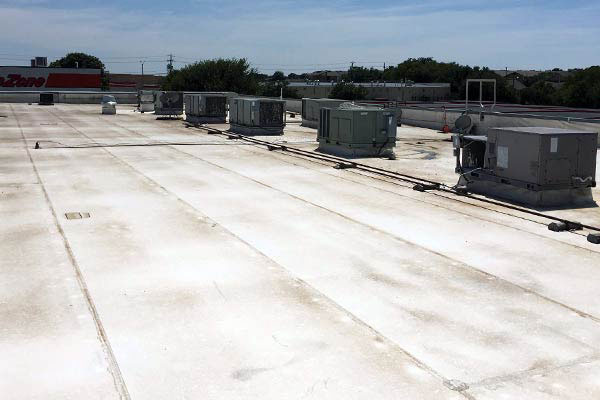
TPO and EPDM are two of the most common materials used in modern commercial roofing. Both are categorized as single-ply membranes (meaning they are single-layer roofing systems) and are best known for being cost-effective, lightweight, and easy to install.
It’s worth pointing out that both EPDM and TPO are suitable substrates for a roof coating (aka roof restoration) system. Click here to learn about the advantages of a fluid-applied roof restoration system.
This post highlights the pros and cons of two of the industry’s most popular roofing materials: TPO (Thermoplastic Polyolefin) and EPDM (Ethylene Propylene Diene Monomer).
Lastly, to help us settle the TPO vs EPDM roofing debate, we’ll see how the single-plies stack up to one another with regard to:
- Cost
- Longevity
- Maintenance
- Energy efficiency
- Durability
- Installation
The Pros of TPO Roofing
Cost
TPO is a budget-friendly roofing solution primarily because it’s inexpensive to manufacture. Roofing contractors can also install TPO roofing systems faster than other “multi-layer” systems, significantly cutting labor costs.
Flexibility
TPO is a highly flexible and durable membrane that can withstand extreme weather and UV exposure. It’s also resistant to punctures, biological growth, dirt build-up, impacts, and water damage.
Energy Efficiency
TPO membranes are predominantly white. As such, they provide a highly reflective and UV-resistant finish capable of reducing roof surface temperatures and cutting interior cooling costs during warmer months.
Easy to Install
TPO is lightweight, so it’s relatively easy to move around on roof surfaces. The installation of wider sheets reduces the number of seams that must be welded, significantly reducing installation time and labor costs.
The Cons of TPO Roofing
Longevity
As a newer roofing technology, the projected lifespan of TPO is somewhat of an unknown, but most estimates are between 10-25 years. Additionally, there are disparities in the manufacturing process of TPO (from one manufacturer to the next), resulting in some material formulations not lasting much past the 10-year mark.
Heat Loads
Excessive heat loads on TPO membranes can eventually cause the seams and flashings to pull apart. It can also cause cracks to form in the membrane’s laminated top layer, making the material more susceptible to damage.
Quality Variances
As mentioned above, TPO is a newer single-ply membrane—meaning material formulations are still being perfected. As a result, there exist many lesser-quality variations of TPO in the market.
Recommended reading: For a more comprehensive overview of TPO roofing, click here.
The Pros of EPDM Roofing
Cost
EPDM systems are relatively inexpensive compared to other commercial roofing solutions. Ballasted EPDM is the most affordable assembly method for EPDM roofing systems, with fully adhered and mechanically attached being slightly more expensive.
Longevity
Perhaps the best characteristic of an EPDM roof is its long lifespan. A properly installed and maintained EPDM system can last up to 40 years or more, significantly longer than other single-ply membranes.
Easy to Install
EPDM is a lightweight material manufactured into wide rolls that are quick and easy to install. As a result, the installation time and labor costs associated with EPDM roofing systems are significantly reduced.
Easy to Maintain
Because of the wide rolls, EPDM roof systems yield fewer seams, significantly reducing maintenance and repair costs over the system’s lifespan. EPDM is also easy to repair (or patch).
Environmentally Friendly
The manufacturing process of EPDM has a minimal environmental impact, and the membrane is 100% recyclable.
The Cons of EPDM Roofing
Durability
As EPDM membranes age, they become more prone to sudden damage (i.e., hail, wind-driven debris, foot traffic, rooftop equipment, etc.).
Shrinkage
Shrinkage is when the EDPM membrane constricts and separates (referred to as bridging) around sensitive roof areas such as parapet walls, seams, and penetrations. It occurs gradually over time and is typically the result of poor installation or bad design.
Aesthetics
Over time, EPDM roofs tend to become rather unsightly due to the build-up of dirt, dust, and other foreign contaminants. This issue is primarily cosmetic and can be avoided with regular cleaning.
Seam Adhesion
Over time, the adhesives that bond the seams of EPDM roofing systems tend to dry out and weaken. This lack of adhesion can cause tiny openings to form, thus allowing water to enter the roofing assembly. Shrinkage and poor installation can exacerbate this issue.
Recommended Reading: For a more in-depth look at EPDM roofing, click here.
Comparison: TPO vs EPDM Roofing
Now that we know the strengths and limitations of TPO and EPDM roofing, let’s see how the two membranes stack up concerning a few key metrics:
Cost
TPO and EPDM are similar in cost, but the superior life expectancy of the latter makes it the better investment. But there are several factors to consider when choosing the most cost-effective solution, including climate, weather concerns, building code requirements, roof construction, building aesthetics, warranty requirements, etc.
Longevity
EPDM tends to last longer than TPO. While TPO has become increasingly popular over the last 20 years, it does not have quite the same “proven” track record as EPDM, which has been around for over 60 years.
Maintenance
Regularly scheduled maintenance is highly recommended for both EPDM and TPO roofing systems. Nonetheless, EPDM will likely require more attention over its lifespan due to its adhesively-bonded seams. Also, EPDM membranes have a low resistance to certain solvents, oils, and chemical abrasives.
Energy Efficiency
White TPO membranes offer exceptional thermal reflectivity, significantly reducing cooling costs for buildings in warmer climates. In contrast, black EPDM membranes absorb more of the sun’s heat, which benefits roofs in colder parts of the country.
Ultimately, determining which single-ply performs best regarding energy efficiency depends on the number of cooling/heating days for a given location.
Durability
TPO has a higher resistance to punctures than EPDM. Additionally, TPO seam strength is nearly four times that of an EPDM adhered/taped seam. That said, on average, EPDM roofing membranes are proven to last considerably longer than TPO.
Also, thicker variations of TPO and EPDM membranes typically perform better and last longer.
Keep in mind that the durability and performance of both TPO and EPDM membranes depend on specific environmental factors, proper installation, and routine maintenance.
Installation
Both TPO and EPDM come in rolls that are quick and easy to install. Choosing a contractor specializing in one or the other can make a huge difference in the time frame and quality of the installation.
TPO is installed in one of two ways: mechanically attached (with plates and fasteners) or fully adhered (with bonding adhesives). The seams are heat-welded together with specialized equipment and tools.
EPDM can be mechanically fastened, fully adhered, or ballasted. In ballasted EPDM systems, the membrane is loose-laid on roof surfaces and held in place with gravel, river-washed stones, or concrete pavers. The seams are fused with a specialized bonding adhesive and tape.
Infographic: TPO vs EPDM Roofing

TPO vs EDPM Roofing, Which Is Better?
Now that we have compared the two, which single-ply material is superior: TPO or EPDM? The best answer to this question is: it depends.
While there are many important items to consider, geographical location is probably the most significant determining factor when it comes to choosing between a TPO and EPDM roofing system.
Over the past few decades, TPO has overtaken EPDM as the US’s most widely used single-ply material. This is primarily due to many states adopting building codes with cool-roof requirements. Accordingly, TPO is the best choice for warmer, sunnier climates due to its superior reflectivity and UV resistance.
Having said that, EPDM remains a perfectly viable option for many commercial roofing applications—specifically for those in colder climates. In contrast to white TPO membranes, black EPDM surfaces retain more of the sun’s heat, thus helping to reduce heating costs.
Ultimately, in the case of TPO vs EPDM roofing, choosing the best option for a given location boils down to its number of cooling/heating days. Other important factors, such as roof construction, building code specifications, and warranty requirements, also play a part.
If you are considering a TPO or EPDM roofing system for your building or want to know more about the topics covered in this post, click here to speak with an American WeatherStar service representative.
Related Posts
EPDM “Rubber” Roofing: The Complete Guide
EPDM roofing systems are quite common on commercial and industrial buildings. In fact, until recently, EPDM was the most popular commercial…
The Ultimate Guide to TPO Roofing
TPO roofing systems are an extremely popular choice for commercial and industrial buildings. TPO is a highly durable, UV resistant, and…
Lead Generation is Essential in Commercial Roofing
Whether a commercial roofing company is well established, new to the industry, or anywhere in-between, leads for jobs are essential to success.…











